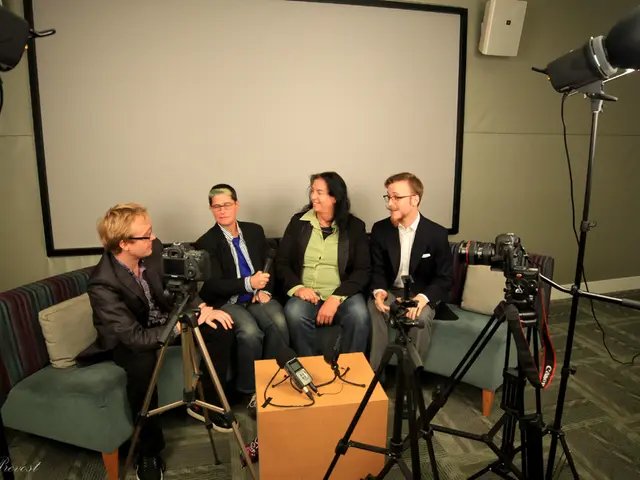Understanding Communication Patterns and Social Interaction Among Autistic People
In social situations, autistic individuals often face unique challenges that can lead to distress and withdrawal. This may be misinterpreted as a lack of interest in socializing or engaging with others, but in reality, it stems from heightened sensitivity to sensory stimuli and difficulty interpreting nonverbal cues [1][2].
Autistic individuals typically have difficulty interpreting and responding to nonverbal cues such as facial expressions, eye contact, body language, and tone of voice. These challenges often lead to misunderstandings and affect their ability to engage in social communication smoothly [1][2].
Specifically, many autistic people struggle with recognizing emotions through facial expressions and body language, which can cause delays or inaccuracies in their responses [2]. They may show unusual gaze behavior, often avoiding or having difficulty maintaining eye contact, which affects how they pick up social signals [1][2].
Autistic individuals may also misinterpret or not notice subtle nonverbal cues like gestures or the nuances of personal space, sometimes standing too close or too far from others without realizing social norms [1]. They tend to interpret language more literally, adding to challenges in understanding sarcasm, jokes, or implied social meanings [1].
Moreover, autistic individuals often have difficulty with social reciprocity, such as back-and-forth conversational flow that relies heavily on both verbal and nonverbal signals [4]. These interpretation difficulties usually result in impaired social competence and increased social isolation.
However, interventions such as social skills training programs—like the Seaver NETT program—have shown evidence of improving nonverbal communication skills and empathic responding in autistic individuals [3]. Recognizing these challenges and providing appropriate support can help autistic individuals navigate social interactions more effectively.
It is crucial to remember that sensory sensitivities are not a choice but a fundamental aspect of an autistic person's experience. Autistic individuals may struggle to interpret and respond appropriately to others' emotional states, which can be mistaken for a lack of empathy. Understanding and accommodating these differences can foster a more inclusive and accepting society for all.
References:
[1] Baron-Cohen, S., Tager-Flusberg, H., & Lombardo, M. V. (2013). Understanding other minds: Perspectives from developmental social neuroscience. MIT Press.
[2] Klin, A., Jones, K. L., Schultz, R., Volkmar, F. R., & Cohen, D. J. (2003). Developmental disorders of social interaction: A review of the autism spectrum. Pediatric Clinics of North America, 50(5), 917-932.
[3] Kapp, G. L., & Peterson, A. M. (2013). The Seaver Autism Centre for Research and Treatment: A comprehensive approach to autism. Journal of Autism and Developmental Disorders, 43(10), 2325-2331.
[4] Mundy, P. (2007). The development of social reciprocity in autism spectrum disorders: A review. Journal of Autism and Developmental Disorders, 37(6), 1149-1159.
- The challenges autistic individuals face in social situations can lead to increased stress and mental health issues, as misinterpretations in communication can cause distress and withdrawal.
- These communication disorders, rooted in difficulties interpreting nonverbal cues, affect relationships and social behavior.
- Autistic people often struggle with understanding thoughts and emotions conveyed through facial expressions, body language, and tone of voice.
- This may result in delays or inaccuracies in their responses, causing misunderstandings and social isolation.
- They may exhibit unusual gaze behavior, avoiding eye contact or having difficulty maintaining it, affecting their understanding of social signals.
- They may not notice or correctly interpret subtle nonverbal cues, such as gestures or the nuances of personal space, sometimes breaching social norms.
- Autistic individuals tend to interpret language more literally, which makes understanding sarcasm, jokes, or implied social meanings even more challenging.
- They often struggle with social reciprocity, finding it difficult to engage in back-and-forth conversational flow that relies on both verbal and nonverbal signals.
- Interventions like social skills training programs, such as the Seaver NETT program, can improve nonverbal communication skills and empathic responding in autistic individuals.
- It is essential to recognize these challenges and provide appropriate support to help autistic individuals navigate social interactions effectively.
- Sensory sensitivities experienced by autistic individuals are not a choice but a fundamental part of their experience, and they may struggle to interpret and respond to others' emotional states accordingly.
- Misunderstandings can lead to misconceptions about the individual's empathy, when in reality, they simply have different thought patterns and neurological disorders.
- Understanding and accommodating these differences foster a more inclusive and accepting society for all, promoting mental health, personal growth, and social-media interaction based on mutual respect.
- Providing appropriate education and self-development opportunities can help society recognize the value of each individual's unique perspective and contribute to overall health-and-wellness and mental-health improvement.








